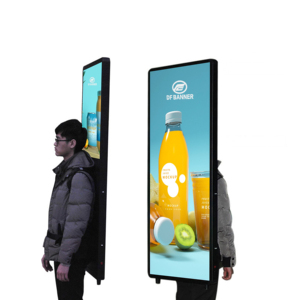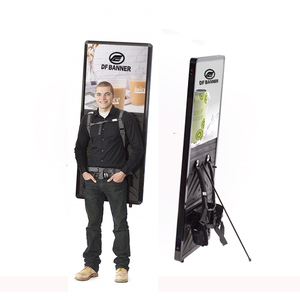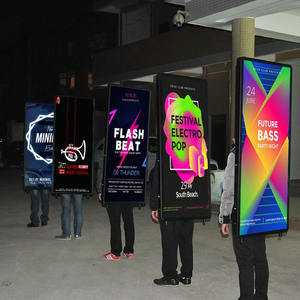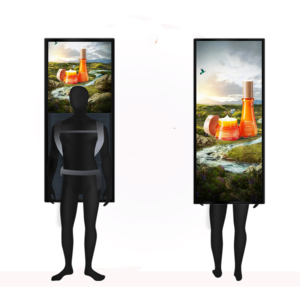
All categories
Featured selections
Trade Assurance
Buyer Central
Help Center
Get the app
Become a supplier

(1638 products available)




















































Billboards are diverse in design and appearance, with each type having unique characteristics and uses. Below are the common types of led walking billboards.
This type of LED billboard has lights on one side only and is a leading billboards advertising choice. It is popular due to its simplicity and low price. Single-sided poster billboards can be installed on a pole, roof, or wall, and they command readers' attention. However, attention doesn't guarantee they will bring advertisers business because some designs are more successful than others. Single-sided billboards should be fitted with creative designs to command traffic if an organization needs to be dynamic in a competitive marketplace.
The major difference between single and double-sided LED billboards is that double-sided billboards have lights on both sides. This setup means that the same advertisement can be viewed from two directions. That increases the density of views without additional structures. Double-sided billboards are ideal for busy streets and roads or areas with high pedestrian activity.
Rotating LED billboards are designed to show more than one advertisement at different times. They are powered either mechanically or by software, with the latter being more efficient. The idea is to place rotating billboards in a single location to target a wider audience with different ads. This setup works particularly well where the same group of people passes regularly. Rotating billboards fitted with several ads can be inexpensive because they require the same structure.
Thanks to the digital media evolution, today billboards can run different ads directed to diverse audiences in real time. For example, if it rains, an ad for umbrellas can be activated. If several people walk by wearing glasses, billboards can display an ad for prescription lenses. Through programmatic advertising, these billboards can show different ads based on the time of day, weather, and audience demographics. This allows companies to target their ads more precisely.
LED billboards with inbuilt technology enable them to connect to advertising platforms and automatically change ads based on set criteria constitute programmatic billboards. They can also give live traffic updates and score sports games.
Although commercial value and quality depend on the type of LED walking billboards, they are closely related to size, location, and target audience. However, larger and more densely populated metropolitan areas attract a higher price due to the volume of people they reach. But, creative content, visibility, and high traffic also affect their cost.
More specifically, the ad format costs more, measuring 6 feet by 3 feet, higher than that measuring 4 feet by 2 feet, owing to its larger size. Pedestrian areas bring higher value because of their audience density than suburban roadways seen by motorists alone. Dynamic ads, like animated LED billboards, cost more than static adverts.
Some key factors that contribute to LED walking billboards' commercial value include the following:
Since there are various electric walking billboards in the market, there are several strategies to fix one that suits the bill poster's advertising needs.
The first step is assessing the objectives for advertising to choose the right LED walking billboards. Key factors include the target audience, messages to be delivered, and desired impact. These aspects determine the suitable location, size, and type of LED walking billboards.
Next, select a proper format. Various formats are available, such as images, videos, social media feeds, and interactive content. Choose a format that best conveys the messages of the campaign to the audience. Also, ensure compliance with legal requirements. LED walking billboards usually attract advertising regulations, so understanding such laws is important to avoid legal issues and, if needed, budget for a license.
The next important step is deciding on the content. Content plays a key role in ensuring billboards are visible and attract attention. Hence, it is important to develop high-quality content that is clear, creative, and relevant to the audience being targeted.
Subsequently, the campaign needs planning. Establish clear campaign goals, such as brand awareness or sales increase, and track relevant key performance indicators (KPIs). Applying these metrics will help in assessing effectiveness and making any necessary real-time adjustments.
Finally, consider interactivity. Today, some LED walking billboards have interactive features like touch screens or social media integration. They allow audiences to engage actively, increasing the impact of the messages further.
Below is a concise table highlighting some key factors for choosing LED walking billboards:
| Key Factors | Considerations | Benefits |
|---|---|---|
| Location | High foot traffic areas | Increased visibility and reach |
| Target audience | Demographics and interests | Relevant messaging |
| Content | Clear and creative | Captures attention |
| Size | Large format | Better readability |
| Interactivity | Engagement features | Enhanced interaction |
Maintaining and repairing LED walking billboards requires some steps to last long and operate efficiently. Some of the maintenance and repair tips are as follows:
A lot of dust and dirt can accumulate on LED billboards. They must be cleaned often, mostly in dirty or dusty areas, to keep their brightness and clarity. Following the manufacturer's recommendations and using the right materials ensure the screen is not damaged while cleaning. Water and soap are enough to clean the outside; manufacturers advise against using harsh chemicals.
This part involves connections between electrical components. Billboards can malfunction, show unclear images, or fail to operate entirely if there is a loose connection. Regularly inspect wires, plugs, and power sources to ensure everything is connected securely.
Using a multimeter can check if the LED screens get the proper voltage. It can also test if a broken screen or other parts are dead. This tool can help spot problems with the billboards early and fix them in time.
If one or more LED lights go out, it can create dark spots on the screen. Keep extra LEDs on hand to replace broken ones quickly and avoid showing incomplete ads.
Billboards can fall or get bumped. They need inspections to be safe and work well. Look closely at the frame and other parts for signs of damage.
Windy and rainy conditions can harm billboards by throwing things at them. Covering LED screens in storms or high winds helps prevent this damage.
LED billboards are sensitive to electricity surges. These power spikes can harm the lights and circuits. Install a voltage regulator to control the electricity and shield the billboards from these spikes. This step will keep them working in top shape for years.
Some billboards control screens with computers inside. Make sure this computer software gets updates to run smoothly. Look online to ensure the software stays current.
A1: LED walking billboards are manufactured using steel, aluminum, and durable plastics. The materials ensure the structure is solid, weather-resistant, and portable. The screens use glass, metal, and advanced polymer to protect the LEDs and electronics from damage. The materials are selected to withstand outdoor conditions.
A2: LEDs, which are commonly used for walking billboards, can last between 6 and 8 years on average They can survive for 100,000 hours or up to 12 years if kept in ideal conditions. They can't survive as long due to harsh environmental factors. They slowly get dimmer over time but usually still work after years.
A3: Walking billboards with LED screens use programmatic advertising that automatically change ads based on data. For example, they can swap in new messages depending on the weather, time of day, or who is nearby. This technology makes sure the right ads are always shown at the right times to the right people.
A4: Walking billboards are an effective advertising means. They bring advertisements directly to crowded areas people often visit, like busy city streets or popular landmarks. Their moving motion captures attention and makes ads stand out even more. Their closeness lets viewers read them better than stationary billboards far away.
A5: Unlike ordinary billboards, LED billboards are digital, bright, and weatherproof. They can switch between different ads quickly and even show full videos or changing colors. While one paper billboard hangs up for weeks, an LED billboard changes every minute.